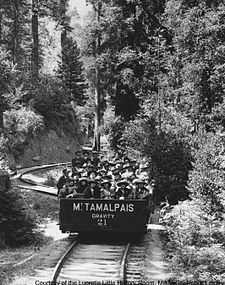Gravity railroad
A gravity railroad (American English) or gravity railway (British English) is a railroad on a slope that allow cars carrying minerals or passengers to coast down the slope by the force of gravity alone. The cars are then hauled back up the slope using animal power or a stationary engine and a cable, a chain or one or more wide, flat iron bands. The speed of the cars is controlled by a braking mechanism on one or more cars on the train. The typical amusement park roller coaster is designed from gravity railroad technology based on the looping track incorporated into the second railroad of the United States, the Mauch Chunk & Summit Hill Railroad, which remained in operation for decades as a tourist attraction and ride after it was withdrawn from freight service hauling coal.
Types of gravity railroad
Some gravity railroads were designed to allow the weight of the descending loaded cars to lift the empty cars back up to the top, using a cable looped around a pulley at the top for a portion of the line. A later revision designed by John B. Jervis, used two separate tracks known as the loaded or heavy track which carried cars loaded with coal to the destination, and the light track, used to return empty cars to the mines. This method allowed cars to travel in a loop, without the need for passing sidings. A stationary steam engine and a looping cable, chain or iron bands were used to raise the empty cars up the lift planes. The cars then coasted down a slight grade to the next lift plane. When cars reversed direction at the ends of the line on a switch or turnout instead of a loop, the railroad was known as a switchback gravity railroad.
Switchback gravity railroad

The term "switchback gravity railroad" is sometimes applied to gravity railroads that used special self-acting (momentum-driven) Y-shaped switches known as switchbacks to automatically reverse a car's direction at certain points as it descends; this essentially folds the incline across the slope in a characteristic "zig-zag" shape. (See diagram: car starts from point A, coasts through switch at B, and comes to a stop at C. Car then rolls through the switch again and proceeds to the switch at D, where the process is repeated.) A separate track was typically used to haul the empty cars back to the top.
The original implementation of this type of system is credited to the Mauch Chunk Switchback Railway, which hauled coal and passengers from 1827 until 1933. This was very popular with tourists, and led to the development of the roller coaster.
Self-acting incline
In the UK, a self-acting incline is one in which the loaded wagons going down pull, via a cable and drum, the empty wagons going up. There might be two separate tracks, or a single track with a passing loop. This system was widely used on slate railways in Wales.
A variation on this system is the cliff railway for passengers. Both passenger cars are equipped with water tanks and, at the start, both tanks are full. Water is then let out of the tank on the lower car until the difference in weight between the two cars causes them to move.
Examples
United Kingdom
The Ffestiniog Railway in Gwynedd, northwest Wales, was built in 1832 to carry slate from quarries high in the hills to the sea at Porthmadog. The line was laid out for the wagons to descend by gravity, while horses were originally used to haul the empty wagons up the hill. On the downward journey the horses travelled in a Dandy waggon at the rear of the train. Later on, steam haulage was adopted. This narrow gauge railway is still operational but all passenger trains are now locomotive-hauled.

Demonstration gravity trains are still occasionally run using original wagons - up to 50 at a time.
United States
In the United States, The Delaware and Hudson Canal Company operated an extensive gravity railroad system from 1828 until 1898. With 22 separate lift planes, the 55-mile (88 km) Pennsylvania Coal Company Gravity Railroad was the longest, and operated until 1885. Equipment and machinery of the railroad was purchased in 1886 by the recently constructed Shohola Glen Summer Resort (1882) and used until 1907.
Due to the success and advancement of the gravity railroads, a gravity operation at Hawley and Pittston was created. This 47 mile route from Paupack Eddy (Hawley) and Port Griffith (Pittston) allowed Pennsylvania Coal Company to directly ship anthracite from its mines to Hudson Canal and Delaware. This means of transportation ultimately led anthracite to the New York markets.
From 1896 through 1929, steam trains carried passengers up Mount Tamalpais in Marin County, California. In 1902, gravity cars began carrying passengers from the mountain's summit down the twisting single-track railway to the city of Mill Valley and starting in 1907, the first tourists into Muir Woods. Gravity service supplemented the steam train service. The powerful steam engines of the Mount Tamalpais & Muir Woods Railway then towed the gravity cars back to the summit for the next scheduled run.
On May 3, 2009, the Gravity Car Barn museum opened at the east peak of Mount Tamalpais to commemorate the old form of transportation. There, a recreated gravity car rolls on eighty-four feet of track.[1]
Other inclined railroads
A funicular is not a true gravity railroad, as cars never coast freely and are always connected to a cable. A rack-and-pinion railway or rack railway is also not a true gravity railroad for similar reasons.
See also
External links
References
- ↑ "Gravity Car Barn". Mt. Tamalpais Interpretive Association, Gravity Car Barn. Retrieved August 26, 2012.